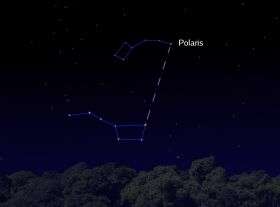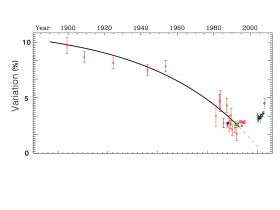The Pole star comes to life again

(PhysOrg.com) -- The Northern Star, whose vibrations were thought to be dying away, appears to have come to life again.
An international team of astronomers has observed that vibrations in the Pole star, which had been fading away to almost nothing over the last hundred years, have recovered and are now increasing. And the astronomers don't know why.

The discovery will be announced during the "Cool Stars 15" conference at the University of St Andrews. Dr Alan Penny from the School of Physics and Astronomy will present results of the recovery to around 350 international delegates at the meeting that runs from July 21-25.
The astronomers were watching Polaris in the expectation that they would catch the star switching off its vibrations completely when they made the surprising observation of its revival.
Dr Penny explained, "It was only through an innovative use of two small relatively unknown telescopes in space and a telescope in Arizona that we were able to discover and follow this star's recovery so accurately."
Team leader, Dr Hans Bruntt of the University of Sydney, had been using a small telescope attached to NASA's now defunct infrared space telescope (WIRE) to study the star for a short period of time. He knew Dr Penny was using a device known as the SMEI space camera - predominately employed to watch matter being ejected from the Sun - to do long-term monitoring of stars. When the SMEI data were analysed this recovery of Polaris was seen, and could also be traced in the WIRE data.
Professor Joel Eaton of Tennessee State University was also doing long-term monitoring, and, using the AST automated spectroscopic telescope located in Arizona, was able to confirm the observations of Polaris by watching the change in velocity of the surface of the star as the variation caused it to expand and contract.
Although Shakespeare's Julius Caesar declared, "I am as constant as the Northern star, Of whose true-fix'd and resting quality There is no fellow in the firmament", Polaris is a 'Cepheid' variable star, getting brighter and fainter every four days. Cepheids do play a vital part as 'standard candles' in determining the size of the Universe, but the details of their variations are not well understood.
Dr Penny said, "One hundred years ago Polaris varied by 10%, but over the last century the variations became smaller and smaller until ten years ago it only varied by 2%.
"It was thought the structure of the star was changing to switch off the vibration. Yet the team has found that about ten years ago the vibrations started picking up and are now back up at the 4% level."
The slow decline in variability was in itself unusual, as no other Cepheid is known to do this. Astronomers thought that Polaris was ageing and its structure was changing so that it was no longer unstable. This was being followed to learn about how stars age. Now Polaris has 'turned on' again this explanation seems unlikely and there may be a complex process in the outer layers of the star, with more than one mode of variability.
The paper will be published in the Aug 10 edition of the 'Astrophysical Journal'. A pre-publication paper is available on arxiv.org/abs/0804.3593
Provided by University of St Andrews





















